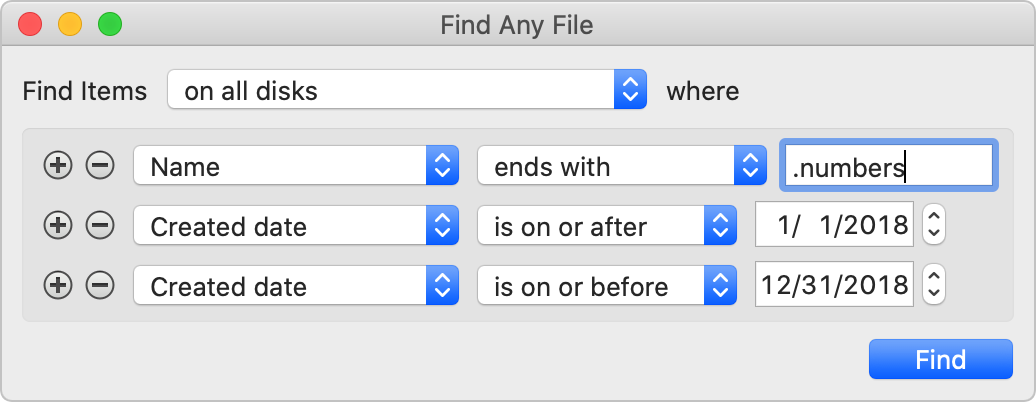
#FIND ANY FILE MAC#
Mac Gems newsletter for a weekly e-mail summary of Gems reviews sent directly to your Inbox. Want to stay up to date with the latest Gems? Sign up for the I keep both utilities on hand, and I use them both regularly. If you want to avoid Spotlight, the freeĮasyFind can search contents and provides a few additional options compared to Find Any File-although I much prefer Find Any File’s search-results display. The biggest drawback of Find Any File is, of course, that it doesn’t search inside files. But here’s a tip: You can just drag the desired search folder onto the location pop-up menu. The trick is to first switch the location to one of the stock locations and then switch back to the custom-folder item, which will bring up the dialog to choose a new folder. One glitch I did experience is that if you choose a specific folder to search, and you later want to search a different folder, there’s no obvious way to choose another custom search location.

(However, the name of each window is based on the originating search’s first criterion this means that if multiple searches use the same first criterion, there’s no way to determine which window belongs to which search.)
#FIND ANY FILE WINDOWS#
I also like that each time you search, Find Any File opens a new search-results window-it’s handy to be able to keep multiple results windows open at the same time. Double-click one of these saved searches, and Find Any File immediately runs the search again-a useful feature for queries you perform frequently. You can also save your searches as Find Any File documents. Switch to this view, and Find Any File lists each file within its folder hierarchy, letting you see, at a glance, where each found file resides. Select an item and you can view, at the bottom of the window, the folder hierarchy leading to the selected item.īut the more useful listing, in my opinion, is hierarchical (Tree) view. The default window displays a simple list of found items along with each item’s kind, modification date, and (for files) size. The downside is that Find Any File doesn’t search the contents of files.Ĭlick Find, and in a few seconds Find Any File presents its results window. The advantage to this approach is that Find Any File can be faster than Spotlight for finding some files, and Find Any File can find files Spotlight doesn’t index-more on that in a moment. Unlike Tembo, Find Any File doesn’t use OS X’s Spotlight indexes for searching rather, it uses the file system’s search features. Your options for searching include name, modification date, creation date, size, item type (is or is not a folder, is or is not an alias), file-type code, and creator code. But you can modify this item, and you can add as many additional search criteria as you like by clicking More Choices. By default, you get a single search option, set to Name Contains yoursearchterm. Hence, this is not an entire replacement for Spotlight but it can come handy in certain, if not many, situations.Ĭompatibility: macOS 10.Below the location pop-up is where you enter your search criteria.
#FIND ANY FILE MAC OS X#
But even on mounted network volumes of a Mac OS X server it can still be surprisingly fast. On the other hand, it may take a little longer than Spotlight, and it is only fast on HFS(+) volumes. Its powerful and will save you most of the time, as you can add many criteria. Hence it is great for finding system files, for example. Find is the command that most people will give you when you ask where is my file. This allows you to find any file, even those inside packages and others excluded from Spotlight search. Unlike Spotlight (i.e., the Finder’s Find command), it does not access a pre-built database but searches the chosen volume directly.

#FIND ANY FILE CODE#
Find Any File searches your local disks for files by name, creation or modification date, size, or type and creator code (not by content, though).Īs there are other tools with a similar search operation, here are the special features unique to Find Any File:


 0 kommentar(er)
0 kommentar(er)
